Iberian lynx
The Iberian lynx (Lynx pardinus) is a wild cat species endemic to the Iberian Peninsula in southwestern Europe. It is listed as Endangered on the IUCN Red List.[2] In the 20th century, the Iberian lynx population had declined because of overhunting and poaching, fragmentation of suitable habitats; the population of its main prey species, the European rabbit (Oryctolagus cuniculus), experienced a severe decline caused by myxomatosis and rabbit haemorrhagic disease.[3][4][5]
| Iberian lynx | |
|---|---|
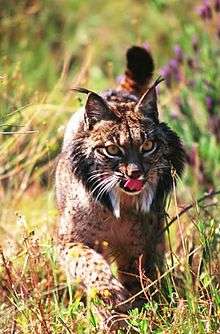 | |
| Scientific classification | |
| Kingdom: | Animalia |
| Phylum: | Chordata |
| Class: | Mammalia |
| Order: | Carnivora |
| Suborder: | Feliformia |
| Family: | Felidae |
| Subfamily: | Felinae |
| Genus: | Lynx |
| Species: | L. pardinus |
| Binomial name | |
| Lynx pardinus (Temminck, 1827) | |
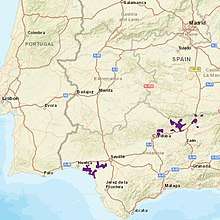 | |
| Distribution of Iberian Lynx, 2015 | |
By the turn of the 21st century, the Iberian lynx was on the verge of extinction, as only about 100 individuals survived in two isolated subpopulations in Andalusia. Conservation measures were implemented since 2002 which included improving habitat, restocking of rabbits, translocating, re-introducing and monitoring Iberian lynxes. By 2012, the population had increased to 326 individuals.[6]
It is a monotypic species and is thought to have evolved from Lynx issiodorensis.
Taxonomy
Felis pardina was the scientific name proposed by Coenraad Jacob Temminck in 1827 who described skins of Iberian lynxes that were killed in the area of the Tagus river in Portugal and were traded in Paris and London.[7] It is a monotypic species.[8]
Characteristics
The Iberian lynx has a short bright yellowish to tawny coloured spotted fur. The spots vary in shape and size from small round to elongate. They are arranged in lines and decrease in size from the back towards the sides.[10] Its head is small with tufted ears and a ruff. Its body is short with long legs and a short tail. Head and body length of males is 74.7–82 cm (29.4–32.3 in) with a 12.5–16 cm (4.9–6.3 in) long tail and a weight of 7–15.9 kg (15–35 lb). Females are smaller with a head-to-body-length of approximately 68.2–77.5 cm (26.9–30.5 in) and a weight of 9.2–10 kg (20–22 lb).[11]
Distribution and habitat
The Iberian lynx was once present throughout the Iberian Peninsula and southern France. In the 1950s, the northern population extended from the Mediterranean to Galicia and parts of northern Portugal, and the southern population from central to southern Spain.[12] Populations declined from 15 subpopulations in the 1940s to only two subpopulations in the early 1990s, most noticeably in Montes de Toledo and Sierra Morena. Before 1973, it was present in Sierra de Gata, Montes de Toledo, eastern Sierra Morena, Sierra de Relumbrar and coastal plains in the Doñana area. Between the early 1960s and 2000, it has lost about 80% of its former range.[13][14] It is now restricted to very limited areas in southern Spain, with breeding only confirmed in Sierra Morena and Doñana coastal plains.[3]
Fossil remains indicate that the Iberian lynx had a wider range during the Late Pleistocene and Holocene. Five lynx remains found in Arene Candide in northern Italy date to about 24,820–18,620 before present. One specimen found in Cabias cave in southern France was radiocarbon dated to 3780±90 before present.[15]
The Iberian lynx prefers heterogeneous environments of open grassland mixed with dense shrubs such as strawberry tree, mastic, and juniper, and trees such as holm oak and cork oak. It is now largely restricted to mountainous areas.
Behaviour and ecology
The Iberian lynx marks its territory with its urine, scratch marks on the barks of trees, and scat. The home ranges of adults are stable over many years.[11] Camera trapping surveys in the eastern Sierra Morena Mountains between 1999 and 2008 revealed that six females had home ranges of 5.2–6.6 km2 (2.0–2.5 sq mi). Four males in the area had home ranges of 11.8–12.2 km2 (4.6–4.7 sq mi).[16]
Diet and hunting
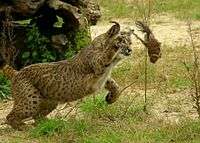
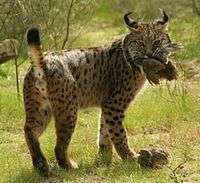
The Iberian lynx preys foremost on the European rabbit (Oryctolagus cuniculus) for the bulk of its diet, supplemented by red-legged partridge (Alectoris rufa), rodents and to a smaller degree also on wild ungulates.[17][18][19] It sometimes preys on young fallow deer (Dama dama), roe deer (Capreolus capreolus), mouflon (Ovis orientalis), and ducks.[20] A male requires one rabbit per day while a female raising kittens will eat three per day.[21]
The Iberian species has low adaptability—it continued to rely heavily on rabbits (75% of its food intake) despite the latter's repeated population crashes due to myxomatosis and rabbit haemorrhagic disease.[5]
It competes for prey with red fox (Vulpes vulpes), Egyptian mongoose (Herpestes ichneumon) and European wildcat (Felis silvestris). Also, it often kills other smaller carnivores such as red fox, Egyptian mongoose and common genet (Genetta genetta).[22] The species is solitary and hunts alone; it will stalk its prey or lie in wait for hours behind a bush or rock until the prey is sufficiently close to pounce in a few strides.
Reproduction

During the mating season the female leaves her territory in search of a male. The typical gestation period is about two months; the kittens are born between March and September, with a peak of births in March and April. A litter consists of two or three (rarely one, four or five) kittens weighing between 200 and 250 grams (7.1 and 8.8 oz).
The kittens become independent at 7 to 10 months old, but remain with the mother until around 20 months old. Survival of the young depends heavily on the availability of prey species. In the wild, both males and females reach sexual maturity at the age of one year, though in practice they rarely breed until a territory becomes vacant; one female was known not to breed until five years old when its mother died. The maximum longevity in the wild is 13 years.[23][24]
Siblings become violent towards one another between 30 and 60 days, peaking at 45 days. A kitten will frequently kill its littermate in a brutal fight. It is unknown why these episodes of aggression occur, though many scientists believe it is related to a change in hormones when a kitten switches from its mother's milk to meat. Others believe it is related to hierarchy, and "survival of the fittest".
Difficulty in finding mates has led to more inbreeding, which results in fewer kittens and a greater rate of non-traumatic death.[25] Inbreeding leads to lower semen quality and greater rates of infertility in males, hindering efforts to increase the species' fitness.[26]
Threats
The Iberian lynx is threatened by habitat loss, road accidents and illegal hunting.[2] Habitat loss is due mainly to infrastructure improvement, urban and resort development and tree mono cultivation, which fragments the lynx's distribution. In the 20th century, rabbit diseases such as myxomatosis and hemorrhagic disease resulted in a dramatic decline of its main prey.[27] Illegal traps set for rabbits and foxes were leading causes for lynx fatality in the 1990s.[28] Every year, several Iberian lynxes die when trying to cross highways with heavy traffic.[3] In 2013, 14 Iberian lynxes died on roads, and 21 in 2014.[29][30]
In 2007, several individuals died of feline leukemia.[31][32]
In 2013, it was reported that the Iberian lynx possesses antibiotic resistant bacteria within its digestive tract, which may lead to more dangerous and difficult-to-treat infections and decrease the cat's fitness.[33] A 2013 study suggests climate change may threaten the Iberian lynx species due to their inability to adapt well to a climate change or it may lead them to relocate to areas that have a more suitable climate but fewer rabbits, increasing mortality.[5]
Conservation
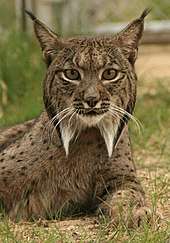
The Iberian lynx is fully protected. It is listed on CITES Appendix I, on Appendix II of the Berne Convention on the Conservation of European Wildlife and Natural Habitats and on Annexes II and IV of the Habitats Directive of the European Union. It has been listed as Endangered on the IUCN Red List since 2014.[2]
Conservation measures include restoring its native habitat, maintaining the wild rabbit population, reducing unnatural causes of death, and releasing captive bred individuals.[34] The Spanish National Commission for the Protection of Nature endorsed the Iberian Lynx Ex Situ Conservation Breeding Program to serve as a "safety net" by managing the captive population and also to "help establish new Iberian lynx free-ranging populations through reintroduction programmes." Before release of captive-bred cats, their natural habit may be simulated to prepare them for life in the wild.[34] A 2006 study used a non-intrusive monitoring system involving cameras to monitor the demographics of both lynxes and rabbits residing in Sierra Morena. Supplemental food sources could be provided if wild rabbits suffered a decline.[35]
Management efforts are being developed to conserve and restore the animal's native range.[36] Officials intending to release captive-bred lynx look for areas of appropriate habitat, rabbit abundance, and acceptance by the local human population.[37] About 90 million euros was spent on various conservation measures between 1994 and 2013.[38] The European Union contributes up to 61% of funding.[39][40]
Reintroduction programme

Beginning in 2009, the Iberian lynx was reintroduced into Guadalmellato, resulting in a population of 23 in 2013.[41] Since 2010, the species has also been released in Guarrizas.[37][42] Discussions were held with the Ministry of Environment on plans for releases in the Campanarios de Azaba area near Salamanca.[43] In April 2013, it was reported that Andalusia's total wild population—only 94 in 2002—had tripled to 309 individuals.[44][41] In July 2013, environmental groups confirmed the presence of a wild-born litter in the Province of Cáceres (Extremadura).[45] A study published in July 2013 in Nature Climate Change advised that reintroduction programs take place in northern Iberia, suggesting that climate change would threaten rabbits in the south.[38][46]
On 26 November 2014, 8 Iberian lynxes were released into Toledo, Spain; one of them traveled near Madrid, the first time in 40 years.[47]
The presence of Iberian lynxes in Portugal, particularly in the south, has been verified.[48] In 2014, the Institute for Nature Conservation and Forests signed contracts securing 2,000 hectares of land for Portugal's reintroduction project.[49][50][51] On 16 December 2014, a pair of Iberian lynx was released into Guadiana Valley Natural Park near Mértola, Portugal.[52] On 7 February 2015, another pair was released into the park, but the female was later found dead on 12 March 2015 after being poisoned in Mértola.[53] The last pair of captive-bred Iberian lynxes were released into Guadiana Valley Nature Reserve on 12 May 2015.[54] By the end of 2015 there were 400 lynx on the Iberian peninsula, the vast majority in Andalusia, in southern Spain, but with smaller new populations in the hills near Toledo, in Extremadura (south-western Spain) and in southern Portugal.[55]
The reintroduction of Iberian lynx in Portugal has been a success; from 17 animals that were reintroduced, 12 have already established territories.[56]
Since a 2007 outbreak of feline leukemia virus (FeLV), wild lynxes are tested periodically for possible disease. September–December 2013 samples were negative for FeLV but one male became the first of his species to test positive for feline immunodeficiency virus (FIV) and was placed into quarantine.[57]
Captive breeding
In 2002, the Jerez Zoo confirmed it had three females and was developing a plan for a captive breeding program. One of those females was Saliega, captured as a kitten in April 2002.[58] She became the first Iberian lynx to breed in captivity, giving birth to three healthy kittens on 29 March 2005 at the El Acebuche Breeding Center, in the Doñana Nature Park in Huelva, Spain.[59] Over the following years, the number of births grew and additional breeding centers were opened. In March 2009, it was reported that 27 kittens had been born since the beginning of the program.[60] In 2009, the Spanish government planned to build a €5.5 million breeding center in Zarza de Granadilla.[60] In Portugal the Centro Nacional de Reprodução do Lince-Ibérico (CNRLI) established a breeding center in Silves.[61][62]
There were 14 surviving kittens in 2008 and 15 in 2009. In 2010, intense rain and health issues resulted in lower reproductive success—14 born, 8 surviving[63]—but the next year, breeding centers recorded 45 births with 26 surviving kittens.[64] In 2012, breeding centers in Portugal and Spain reported a total of 44 survivors from 59 births,[64] while 2013 saw a total of 44 survivors out of 53 born.[65] In 2017, the total population of Iberian lynx reached 475 specimens.[66]
In March 2013, it was reported that Iberian lynx embryos and oocytes had been collected and preserved for the first time. They were collected from Saliega and another female—both sterilized and retired from the breeding program—by Berlin's Leibniz Institute for Zoo and Wildlife Research and stored in liquid nitrogen at the Museo Nacional de Ciencias Naturales in Madrid for possible future breeding.[67] In July 2014, the MNCN-CSIC announced they had produced sperm cells from the testicular tissue of sexually immature lynx.[68]
Iberian lynx can be observed in captivity only at the Jerez Zoo,[69] since December 2014 at the Lisbon Zoo,[70] and since July 2016 at the Madrid Zoo.[71] The Jerez animals integrate the breeding program, the two Lisbon lynxes were formerly in the Portuguese breeding center but are no longer suited for the program (the female had multiple failed pregnancies and the male has a form of epilepsy),[72] and the two Madrid lynxes were equally retired from the breeding program for not being suited for reproduction.
Genetic research
The genetic diversity of the Iberian lynx is lower than in any other genetically impoverished felid, which is possibly a consequence of fragmentation and isolation of population units.[73] Iberian lynxes in Doñana and Andujar differ genetically at microsatellite markers. Samples collected in Doñana exhibited a high degree of inbreeding as this unit was isolated for a long time.[73]
See also
- Bobcat, Lynx rufus
- Canadian lynx, Lynx canadensis
- Eurasian lynx, Lynx lynx
- Felicola isidoroi
References
- Boscaini, A.; Alba, D.M.; Beltrán, J.F.; Moya-Sola, S. & Madurell-Malapeira, J. (2016). "Latest Early Pleistocene remains of Lynx pardinus (Carnivora, Felidae) from the Iberian Peninsula: taxonomy and evolutionary implications". Quaternary Science Reviews. 143: 96–106. doi:10.1016/j.quascirev.2016.05.015.
- Rodríguez, A. & Calzada, J. (2015). "Lynx pardinus". IUCN Red List of Threatened Species. 2015: e.T12520A50655794. Retrieved 29 October 2018.
- Simón, M.A. (2012). Ten years conserving the Iberian lynx. Seville: Consejería de Agricultura, Pesca y Medio Ambiente. Junta de Andalusía. ISBN 9788492807802.
- Rodríguez-Hidalgo, A.; Lloveras, L.; Moreno-García, M.; Saladié, P.; Canals, A.; Nadal, J. (2013). "Feeding behaviour and taphonomic characterization of non-ingested rabbit remains produced by the Iberian lynx (Lynx pardinus)". Journal of Archaeological Science. 40 (7): 3031–3045. doi:10.1016/j.jas.2013.03.006. hdl:10261/153608.
- Fordham, D.A.; Akçakaya, H.R.; Brook, B.W.; Rodríguez, A.; Alves, P.C.; Civantos, E.; Trivino, M.; Watts, M.J. & Araujo, M.B. (2013). "Adapted conservation measures are required to save the Iberian lynx in a changing climate" (PDF). Nature Climate Change. 3 (10): 899–903. Bibcode:2013NatCC...3..899F. doi:10.1038/nclimate1954. hdl:10261/84387.
- Lopez, G.; Lopez, M.; Fernandez, L.; Ruiz, G.; Arenas, R.; Del Rey, T.; Gil, J.M.; Garrote, G.; Garcia, M. & Simon, M. (2012). "Population development of the Iberian lynx since 2002". Cat News. 57: 34.
- Temminck, C. J. (1827). "Felis pardina". Monographies de mammalogie, ou description de quelques genres de mammifères, dont les espèces ont été observées dans les différens musées de l'Europe. Vol. 1. Leiden: C. C. Vander Hoek. pp. 116−117.
- Kitchener, A. C.; Breitenmoser-Würsten, C.; Eizirik, E.; Gentry, A.; Werdelin, L.; Wilting, A.; Yamaguchi, N.; Abramov, A. V.; Christiansen, P.; Driscoll, C.; Duckworth, J. W.; Johnson, W.; Luo, S.-J.; Meijaard, E.; O’Donoghue, P.; Sanderson, J.; Seymour, K.; Bruford, M.; Groves, C.; Hoffmann, M.; Nowell, K.; Timmons, Z.; Tobe, S. (2017). "A revised taxonomy of the Felidae: The final report of the Cat Classification Task Force of the IUCN Cat Specialist Group" (PDF). Cat News. Special Issue 11: 45.
- Kurtén, B. (1968). Pleistocene Mammals of Europe. London, New Brunswick: Aldine Transaction.
- Beltrán, J.F.; Delibes, M. (1993). "Physical characteristics of Iberian lynxes (Lynx pardinus) from Doñana, southwestern Spain". Journal of Mammalogy. 74 (4): 852–862. doi:10.2307/1382423. JSTOR 1382423.
- Sunquist, M. & Sunquist, F. (2002). "Iberian Lynx Lynx pardinus (Temminck, 1827)". Wild cats of the World. Chicago: University of Chicago Press. pp. 177–184. ISBN 978-0-226-77999-7.
- Clavero, M. & Delibes, M. (2013). "Using historical accounts to set conservation baselines: the case of Lynx species in Spain". Biodiversity and Conservation. 22 (8): 1691–1702. doi:10.1007/s10531-013-0506-4. hdl:10261/80444.
- Alda, F.; Inogés, J.; Alcaraz, L.; Oria, J.; Aranda, A. & Doadrio, I. (2008). "Looking for the Iberian lynx in central Spain: a needle in a hay stack?". Animal Conservation. 11 (4): 297–305. doi:10.1111/j.1469-1795.2008.00185.x.
- Gil-Sanchez, J.M. & McCain, E.B. (2011). "Former range and decline of the Iberian lynx (Lynx pardinus) reconstructed using verified records". Journal of Mammalogy. 92 (5): 1081–1090. doi:10.1644/10-MAMM-A-381.1.
- Rodríguez-Varela, R.; Tagliacozzo, A.; Ureña, I.; García, N.; Crégut-Bonnoure, E.; Mannino, M. A.; Arsuaga, J. L. & Valdiosera, C. (2015). "Ancient DNA evidence of Iberian lynx palaeoendemism". Quaternary Science Reviews. 112: 172–180. Bibcode:2015QSRv..112..172R. doi:10.1016/j.quascirev.2015.01.009.
- Gil-Sánchez, J.M.; Moral, M.; Bueno, J.; Rodríguez-Siles, J.; Lillo, S.; Pérez, J.; Martín, J.M.; Valenzuela, G.; Garrote, G.; Torralba, B. & Simón-Mata, M.Á. (2011). "The use of camera trapping for estimating Iberian lynx (Lynx pardinus) home ranges". European Journal of Wildlife Research. 57 (6): 1203–1211. CiteSeerX 10.1.1.459.5581. doi:10.1007/s10344-011-0533-y.
- Palomares, F.; Delibes, M.; Revilla, E.; Calzada, J.; Frediani, J.M. (2001). "Spatial ecology of Iberian lynx and abundance of European rabbits in south-western Spain". Wildlife Monographs. 148 (148): 1–36. JSTOR 3830752.
- Gil-Sánchez, J.M.; Ballesteros-Duperón, E.; Bueno-Segura, J.F. (2006). "Feeding ecology of the Iberian lynx Lynx pardinus in eastern Sierra Morena (Southern Spain)". Acta Theriologica. 51: 85–90. doi:10.1007/bf03192659.
- López‐Bao, J.V.; Palomares, F.; Rodríguez, A.; Ferreras, P. (2011). "Intraspecific interference influences the use of prey hotspots". Oikos. 120 (10): 1489–1496. doi:10.1111/j.1600-0706.2011.19194.x. hdl:10261/39785.
- Delibes, A.; Rodríguez, M.; Ferreras, P. (2000). Action Plan for the Conservation of the Iberian Lynx in Europe (Lynx pardinus) (PDF). Council of Europe. ISBN 978-92-871-4423-2.
- Ward, D. (2004). The Iberian Lynx Emergency (PDF). EU commissioned report.
- Fedriani, J. M.; Palomares, F.; Delibes, M. (1999). "Niche relations among three sympatric Mediterranean carnivores". Oecologia. 121 (1): 138–148. Bibcode:1999Oecol.121..138F. CiteSeerX 10.1.1.587.7215. doi:10.1007/s004420050915. PMID 28307883.
- "Iberian lynx Lynx pardinus". IUCN Cat Specialist Group. Archived from the original on 24 July 2011.
- "Lynx pardinus". Animal Diversity Web.
- Palomares, F.; Godoy, J. A.; Lopez-Bao, J. V. (2012). "Possible Extinction Vortex for a Population of Iberian Lynx on the Verge of Extirpation". Conservation Biology. 26 (4): 689–697. doi:10.1111/j.1523-1739.2012.01870.x. hdl:10261/55052. PMID 22731698.
- Ruiz-Lopez, M. J.; Ganan, N.; Godoy, J. A. (2013). "Heterozygosity-Fitness Correlations and Inbreeding Depression in two Critically Endangered Mammals". Conservation Biology. 26 (1): 1121–1129. doi:10.1111/j.1523-1739.2012.01916.x. hdl:10261/63937. PMID 22897325.
- Delibes-Mateos, M.; Ferreira, C.; Carro, F.; Escudero, M. A. & Gortázar, C. (2014). "Ecosystem Effects of Variant Rabbit Hemorrhagic Disease Virus, Iberian Peninsula". Emerging Infectious Diseases. 20 (12): 2166–2168. doi:10.3201/eid2012.140517. PMC 4257825. PMID 25417710.
- Ferreras, P.; Aldama, J.J.; Beltran, J. & Delibes, M. (1992). "Rates and causes of mortality in a fragmented population of Iberian lynx Felis pardina Temminck, 1824". Biological Conservation. 62 (3): 197–202. doi:10.1016/0006-3207(92)91116-a. hdl:10261/50936.
- "El atropello mortal de 14 linces en 2013 merma la recuperación de la especie" [14 lynxes were fatally run over in 2013, undermining the species' recovery]. Andaluces Diario (in Spanish). 2014. Archived from the original on 6 January 2014. Retrieved 6 January 2014.
- Donaire, G. (2015). "Rise in Iberian lynx road deaths speeds up protection plans". El País.
- López, G.; López-Parra, M.; Fernández, L.; Martínez-Granados, C.; Martínez, F.; Meli, M.L.; Gil-Sánchez, J.M.; Viqueira, N.; Díaz-Portero, M.A.; Cadenas, R.; Lutz, H.; Vargas, A. & Simón, M.A. (2009). "Management measures to control a feline leukemia virus outbreak in the endangered Iberian lynx". Animal Conservation. 12 (3): 173–182. doi:10.1111/j.1469-1795.2009.00241.x.
- Palomares, F.; López-Bao, J.V. & Rodríguez, A. (2011). "Feline leukaemia virus outbreak in the endangered Iberian lynx and the role of feeding stations: a cautionary tale". Animal Conservation. 14 (3): 242–245. doi:10.1111/j.1469-1795.2010.00403.x. hdl:10261/39812.
- Gonçalves, A.; Igrejas, G. & Hajer, T. (2013). "Detection of antibiotic resistant enterococci and Escherichia coli in free range Iberian Lynx (Lynx pardinus)". Science of the Total Environment. 456–457: 115–119. Bibcode:2013ScTEn.456..115G. doi:10.1016/j.scitotenv.2013.03.073. PMID 23588135.
- Vargas, A., Sánchez, I., Martínez, F., Rivas, A., Godoy, J.A., Roldan, E., Simón, M.A., Serra, R., Perez, M.A.J., Ensenat, C. and Delibes, M. (2008). "The Iberian lynx Lynx pardinus Conservation Breeding Program" (PDF). International Zoo Yearbook. 42: 190–198. doi:10.1111/j.1748-1090.2007.00036.x. hdl:10261/50244.CS1 maint: uses authors parameter (link)
- Gil-Sánchez, J.; Simón, M.; Cadenas, R.; Bueno, J.; Moral, M.; Rodríguez-Siles, J. (2010). "Current Status Of the Iberian Lynx (Lynx pardinus) in eastern Sierra Morena, Southern Spain". Wildlife Biology in Practice. 6 (3): 14–33. doi:10.2461/wbp.lynx.2.
- Clavero, M.; Delibes, M. (2013). "Using historical accounts to set conservation baselines: the case of Lynx species in Spain". Biodiversity Conservation Journal. 22 (8): 1691–1702. doi:10.1007/s10531-013-0506-4. hdl:10261/80444.
- Alves, F. (21 June 2013). "Lince-ibérico: Jazz e Joaninha, que nasceram em Silves em 2012, foram hoje libertados na Andaluzia" [Iberian lynx: Jazz and Joaninha, who were born in Silves in 2012, were released today in Andalusia]. Naturlink (in Portuguese). Archived from the original on 30 June 2013.
- "Iberian lynx threatened by climate change". The University of Adelaide. 22 July 2013.
- Viúdez, J. (15 December 2013). "Iberian lynx faces new threat as disease decimates rabbit population". El Pais.
- "El lince ibérico inicia una incierta <<reconquista>>" [The Iberian lynx begins an uncertain "reconquest"]. EFE (in Spanish). ABC.es. 2009.
- "La Junta de Andalucía refuerza en el Guadalmellato la población de lince ibérico con la suelta de dos ejemplares" [Andalusia reinforces Iberian lynx population in Guadalmellato with the release of two individuals]. El Economista (in Spanish). 8 April 2013.
- Ward, D. (2008). "LynxBrief" (PDF).
- "Wildlife returns to Western Iberia". Rewilding Europe. 2012.
- "La población de linces se triplica en Andalucía en los últimos diez años" [The lynx population has tripled in Andalusia in the last ten years]. El Mundo (in Spanish). 2013.
- "Grupos ecologistas confirman que el lince ibérico cría en libertad en Cáceres" [Environmental group confirm the Iberian lynx is breeding in the wild in Cáceres]. EFE (in Spanish). ABC.es. 2013.
- Ghose, Tia (2013). "Climate Change Could Wipe Out Iberian Lynx". Live Science.
- "Iberian Lynx returns to Madrid region after 40 years". El Pais. 10 March 2015.
- Soares, M. (2013). "Lince ibérico, o mais ameaçado dos felinos, fotografado em Milfontes" [The Iberian Lynx, the most threatened feline, was photographed in Milfontes]. Publico.pt (in Portuguese).
- "Lynx pardinas (2000)". ICNF Portal (in Portuguese). ICN:B. Retrieved 27 June 2017.
- Lynx pardinus. Instituto da Conservação da Natureza e das Florestas, Portugal
- Bratley, Carrie-Marie (13 November 2014). "More space in Portugal in pipeline for Iberian Lynx". The Portugal News. Archived from the original on 8 December 2014. Retrieved 8 December 2014.
- "Portugal makes history with first release of Iberian Lynx". The Portugal News. 18 December 2014.
- "Iberian Lynx female released last month found dead". The Portugal News. 19 March 2015.
- "Final two Iberian Lynx released into the wild". theportugalnews.com. The Portugal News. 14 May 2015.
- "The return of the lynx". bbc.com. BBC. 28 March 2016. Retrieved 12 April 2016.
- "Começou a época de 2017 de libertações de linces em Portugal". 17 February 2017.
- "Resultado negativo en los chequeos a linces para detectar leucemia felina, con un positivo de virus de inmunodeficiencia" [Lynxes negative for feline leukemia but one positive for immunodeficiency virus]. Europa Press (in Spanish). La Informacion. 2013. Archived from the original on 31 December 2013.
- Gonçalves, E. (April 2002). "Captured cubs hold future of Europe's tiger". London: The Guardian.
- "Hopes raised by Spain lynx births". BBC News. 2005. Retrieved 5 September 2012.
- "Endangered Iberian lynx cubs born in Spain". Associated Press. 20 March 2009.
- Bratley, Carrie-Marie (2013). "Silves-born Iberian lynx released in Spain". The Portugal News. Archived from the original on 20 March 2014. Retrieved 10 July 2013.
- Tomás, Carla; de Atayde, André (2 April 2013). "Quinze crias de lince ibérico nascem em Silves" [Fifteen Iberian lynx cubs born in Silves]. Expresso.sapo.pt (in Portuguese).
- Sierra, David (2010). "Fallece 'Geo', uno de los cachorros de lince ibérico nacido en cautividad este año" [Death of 'Geo', one of this season's captive-born Iberian lynx cubs] (in Spanish). rtve.es.
- "Nacen 59 ejemplares de lince esta temporada en el Programa de Cría en Cautividad" [59 lynx kittens born this season as part of the Captive Breeding Program]. Europa Press (in Spanish). 17 June 2012.
- "El programa de cría en cautividad del lince ibérico acaba la temporada con 44 cachorros" [The lynx captive breeding program ends the season with 44 cubs]. EFE (in Spanish). 20minutos.es. 2013.
- "El lince ibérico amplía sus dominios y alcanza los 475 ejemplares, pese a la falta de conejos y los atropellos". La Vanguardia. Retrieved 11 July 2017.
- "For the first time Iberian lynx embryos are collected and preserved". Forschungsverbund Berlin e.V. (FVB). phys.org. 2013.
- Mosquera Rodriguez, E. (2014). "Esperma 'de laboratorio' para salvar al lince ibérico" [Laboratory-made sperm to save the Iberian lynx]. El Mundo (in Spanish).
- "The Iberian Lynx at the Zoobotanico de Jerez (in Spanish)".
- Novais, V. (2014). "Os felinos mais ameacados do mundo ja moram em Lisboa" [O casal de linces-ibéricos chegou ao Jardim Zoológico de Lisboa com uma missão especial: mostrar aos visitantes o que os torna os felinos mais ameaçados do mundo]. Observador (in Portuguese).
- "Llega a Zoo Aquarium de Madrid una pareja de linces ibéricos del proyecto Iberlince". Zoo Aquarium Madrid. 20 July 2016.
- Figueiredo, Filipe (2015). "Nova Visita ao Zoo de Lisboa – O Lince Ibérico" [New visit to the Lisbon Zoo – The Iberian Lynx]. O Último Reduto (in Portuguese). Archived from the original on 10 February 2016.
- Casas-Marce, M.; Soriano, L.; López-Bao, J. V. & Godoy, J. A. (2013). "Genetics at the verge of extinction: insights from the Iberian lynx". Molecular Ecology. 22 (22): 5503–5515. doi:10.1111/mec.12498. PMID 24128177.
External links
| Wikimedia Commons has media related to Lynx pardinus. |
| Wikispecies has information related to Lynx pardinus |
- Large Carnivore Initiative for Europe – Iberian lynx
- Programa de Conservación Ex-Situ Official Spanish government page (in Spanish)
- Species portrait Iberian lynx; IUCN/SSC Cat Specialist Group
- ARKive – Images and movies of the Iberian lynx (Lynx pardinus)
- The natural history of the Iberian lynx
- Lynx in vertebradosibericos.org (in Spanish)
- WWF species profile: Iberian lynx
- Lynx pardinus in Naturdata (in Portuguese)
